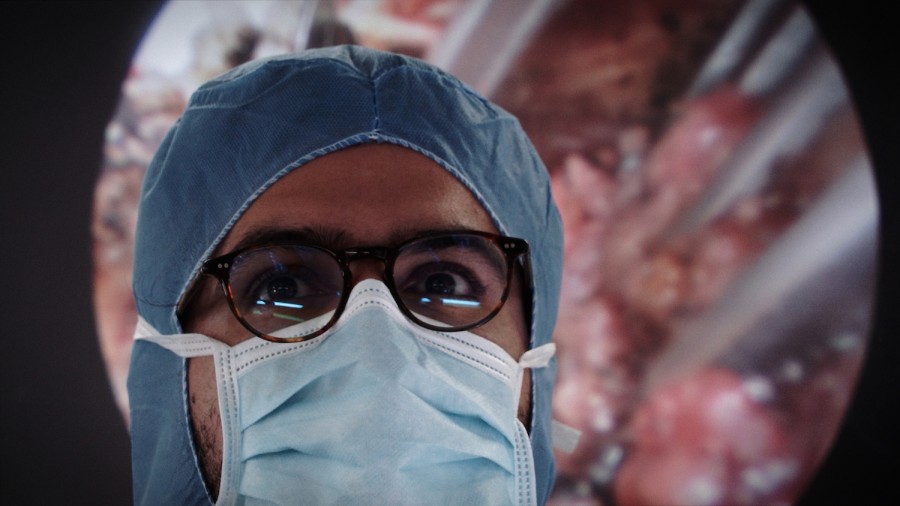Review: ‘De Humani Corporis Fabrica’ cuts deep into the human body
In their latest documentary feature, Véréna Paravel and Lucien Castaing-Taylor bring viewers on a transformational journey of human anatomy. “De Humani Corporis Fabrica” is currently showing at the IFC Center.
May 1, 2023
The intrusive lens of the micro camera burrows through cavernous organs and once unseen crevices of the human body in “De Humanis Corporis Fabrica.” First premiered at the 2022 Cannes Film Festival, Véréna Paravel and Lucien Castaing-Taylor’s documentary film is a revelatory cinematic inquisition into the mesmerizing horror of man’s interior world. In collaboration with Harvard’s Sensory Ethnography Lab, they employ specially built cameras to record hospital life from a never-before-seen perspective.
The film’s title, translated in English as “On the Fabric of the Human Body,” aptly captures both directors’ treatment of showcasing human anatomy. Footage of endoscopies, cell slides and up-close surgical incisions are intricately woven into a fleshy tapestry of hospital life, jarringly transporting the viewer between interior and exterior spaces. While footage of hospitals and medical procedures can often feel clinical and detached, Paravel and Castaing-Taylor create an experience that is uncomfortably personal.
With their previous films such as “Leviathan” (2012), which used GoPro cameras to record the majestic brutality of life on a fishing trawler, the seasoned documentary duo turned its gaze inward. Having filmed in multiple Paris hospitals, Paravel and Castaing-Taylor’s cameras intimately record the quotidian processes, both medical and social, in the health care sector.
One of the first procedures featured in the film is a man’s brain surgery. The camera lingers on the patient’s face as a doctor probes a metal tool into a hole in his skull. Abruptly, the film cuts into the inside world of the surgery. White light envelops every fiber and membrane like a searchlight examining a cramped sea cave.
Throughout the film, the inner workings of the body are treated like a morbid natural landscape. Unique angles and dynamic camera maneuvers are employed, engrossing viewers in the obscenely magnetic textures and complex machinations of human biology. As the camera floats from one body to the next, the directors accompany evocative imagery with an otherworldly sonic environment. Muffled conversations among surgeons are layered on top of the sound of bodily fluids and medical contraptions, creating a symphony of man and machine in the operating room.
While the primary focus of the film is on the interplay between the interior human body and the exterior milieu of the operating room, the hospital itself is treated as a paradoxical terminal where life and death come to pass. Babies are born while doctors carefully examine pieces of cancerous flesh — blackened tissue which looks more like a fossil than a human appendage. Young medical professionals engage in intricate procedures while making phallic jokes, while old and possibly senile patients wander the hospital halls aimlessly. While the documentarians never interview nor directly interact with the staff, viewers feel the heavy emotional burden of working in medical spaces. Surgeons, nurses and other health care workers are not only on the frontiers of the human body, but are also constantly dancing at the boundary of human mortality.
As much as Paravel and Castaing-Taylor illustrate the beauty of life and the body’s inner workings, death constantly looms over the film. This microscopic view of surgery reinforces the idea that bodily functions are constantly under threat and gradually deteriorating.
In one of the film’s most visually gruesome scenes, a group of surgeons uses a set of robotic arms to extract a patient’s prostate. A complication in the process causes internal bleeding within the patient, leading to a frenzied panic in the room. The thin, metallic arms scramble to stitch the cut, as crimson blood gushes into the open cavity. Surgeons, who were calm and collected only moments ago, now scramble to repair the damage. While the innards of the patient and the doctors in the operating room both begin to rapidly descend into a chaotic state, the filmmakers cut away to another scene in hospital life. The viewer, deprived of knowing the outcome of the surgery, is left with a haunting image of a man at his most vulnerable, lying on his back as he bleeds out on the operating table. Doctors, with the sole purpose of preserving life, are captured at a seemingly helpless moment as they fight against the body’s self-destruction.
Paravel and Castaing-Taylor are not simply undertaking an exploitative look into the private world of the body. “De Humani Corporis Fabrica” is a corporeal journey of lives that intersect in the hospital, a liminal space between birth and passing. The documentary pushes the bounds of cinema, the body, and life itself as it delivers audiences an unexpectedly emotional cinematic narrative.
Contact Mick Gaw at [email protected].




























































































































































